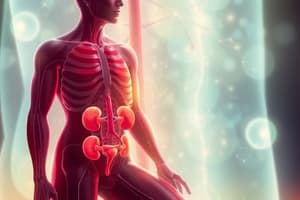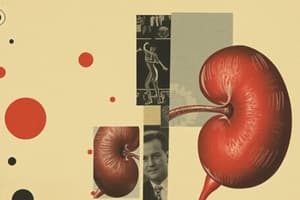Podcast
Questions and Answers
Which of the following segments of the nephron is impermeable to water, but actively reabsorbs sodium, chloride, potassium, and other ions?
Which of the following segments of the nephron is impermeable to water, but actively reabsorbs sodium, chloride, potassium, and other ions?
- Early distal tubule
- Late distal tubule
- Thick ascending loop of Henle (correct)
- Descending loop of Henle
What is the approximate osmolarity of the fluid in the early distal tubule?
What is the approximate osmolarity of the fluid in the early distal tubule?
- 120 milliosmoles
- 100 milliosmoles
- 1200 milliosmoles
- 140 milliosmoles (correct)
How does the presence of ADH affect the osmolarity of the fluid in the late distal tubule and cortical collecting tubules?
How does the presence of ADH affect the osmolarity of the fluid in the late distal tubule and cortical collecting tubules?
- ADH decreases the osmolarity of the fluid.
- ADH increases the osmolarity of the fluid by increasing water permeability. (correct)
- ADH decreases the osmolarity of the fluid by increasing water permeability.
- ADH has no effect on the osmolarity of the fluid.
What is the primary mechanism by which the osmolarity of the medullary interstitium is established?
What is the primary mechanism by which the osmolarity of the medullary interstitium is established?
Which of the following statements about urea transport in the inner medullary collecting ducts is CORRECT?
Which of the following statements about urea transport in the inner medullary collecting ducts is CORRECT?
Which of the following segments of the nephron is highly permeable to water due to the presence of aquaporins?
Which of the following segments of the nephron is highly permeable to water due to the presence of aquaporins?
What is the primary mechanism for regulating ADH secretion during simple dehydration?
What is the primary mechanism for regulating ADH secretion during simple dehydration?
What is the primary factor that determines the osmolarity of the fluid in the intermediary collecting ducts?
What is the primary factor that determines the osmolarity of the fluid in the intermediary collecting ducts?
What specific structure within the hypothalamus is responsible for synthesizing ADH?
What specific structure within the hypothalamus is responsible for synthesizing ADH?
How does the kidney achieve the excretion of a highly concentrated urine?
How does the kidney achieve the excretion of a highly concentrated urine?
Which of the following factors does NOT stimulate thirst?
Which of the following factors does NOT stimulate thirst?
What is the primary function of ADH in the body?
What is the primary function of ADH in the body?
How does ADH influence water permeability in the renal tubules?
How does ADH influence water permeability in the renal tubules?
What is the primary stimulus for the release of ADH?
What is the primary stimulus for the release of ADH?
What is the role of the cardiovascular reflexes in regulating ADH release?
What is the role of the cardiovascular reflexes in regulating ADH release?
What are the main routes of fluid loss that require replenishment through fluid intake?
What are the main routes of fluid loss that require replenishment through fluid intake?
What is the primary factor that stimulates the thirst mechanism?
What is the primary factor that stimulates the thirst mechanism?
Which of the following is NOT a mechanism for stimulating thirst?
Which of the following is NOT a mechanism for stimulating thirst?
How does angiotensin II contribute to thirst regulation?
How does angiotensin II contribute to thirst regulation?
What is the threshold for activating the thirst mechanism?
What is the threshold for activating the thirst mechanism?
How do the thirst and ADH mechanisms work together to regulate fluid balance?
How do the thirst and ADH mechanisms work together to regulate fluid balance?
What does the graph demonstrate regarding sodium intake and plasma sodium concentration?
What does the graph demonstrate regarding sodium intake and plasma sodium concentration?
What happens to plasma sodium concentration when the ADH and thirst mechanisms are blocked?
What happens to plasma sodium concentration when the ADH and thirst mechanisms are blocked?
What is the main function of the 'obligatory' water excretion by the kidneys?
What is the main function of the 'obligatory' water excretion by the kidneys?
What is the primary regulator of extracellular fluid osmolarity?
What is the primary regulator of extracellular fluid osmolarity?
What is the consequence of increased extracellular fluid osmolarity?
What is the consequence of increased extracellular fluid osmolarity?
How much urine is required to excrete 600 million osmosis solutes?
How much urine is required to excrete 600 million osmosis solutes?
What accounts for the majority of solutes in the extracellular plasma?
What accounts for the majority of solutes in the extracellular plasma?
Which system primarily regulates sodium concentration and osmolarity?
Which system primarily regulates sodium concentration and osmolarity?
What happens at the kidneys when neurosecretory cells stimulate the posterior pituitary?
What happens at the kidneys when neurosecretory cells stimulate the posterior pituitary?
What is the average plasma osmolarity?
What is the average plasma osmolarity?
What role does urea play in osmotic pressure?
What role does urea play in osmotic pressure?
What main factors determine urea excretion in the body?
What main factors determine urea excretion in the body?
In patients with renal disease, what effect does a decrease in GFR have on urea concentration in the plasma?
In patients with renal disease, what effect does a decrease in GFR have on urea concentration in the plasma?
What percentage of filtered urea is typically reabsorbed in the proximal tubule?
What percentage of filtered urea is typically reabsorbed in the proximal tubule?
How does the vasa recta impact the osmolarity of the renal medulla?
How does the vasa recta impact the osmolarity of the renal medulla?
What is the primary reason blood becomes progressively more concentrated as it descends the medulla?
What is the primary reason blood becomes progressively more concentrated as it descends the medulla?
What is the role of the UT A2 transporter in urea excretion?
What is the role of the UT A2 transporter in urea excretion?
Which characteristic describes renal medullary blood flow?
Which characteristic describes renal medullary blood flow?
What occurs to blood as it ascends back out of the medulla?
What occurs to blood as it ascends back out of the medulla?
Flashcards
Urea Filtration
Urea Filtration
The amount of urea filtered from the blood into the kidney.
Urea Reabsorption
Urea Reabsorption
The process where the kidney returns urea back into the bloodstream.
Urea Secretion
Urea Secretion
The movement of urea from the blood into the nephron's tubular fluid.
Glomerular Filtration Rate (GFR)
Glomerular Filtration Rate (GFR)
Signup and view all the flashcards
Countercurrent Multiplier System
Countercurrent Multiplier System
Signup and view all the flashcards
Vasa Recta
Vasa Recta
Signup and view all the flashcards
Proximal Convoluted Tubule (PCT)
Proximal Convoluted Tubule (PCT)
Signup and view all the flashcards
Water Permeability of PCT
Water Permeability of PCT
Signup and view all the flashcards
Obligatory urine volume
Obligatory urine volume
Signup and view all the flashcards
Urine concentrating ability
Urine concentrating ability
Signup and view all the flashcards
Sodium and Fluid Distribution
Sodium and Fluid Distribution
Signup and view all the flashcards
Osmoreceptors
Osmoreceptors
Signup and view all the flashcards
Thirst Mechanism
Thirst Mechanism
Signup and view all the flashcards
Osmoreceptor Feedback
Osmoreceptor Feedback
Signup and view all the flashcards
Antidiuretic Hormone (ADH)
Antidiuretic Hormone (ADH)
Signup and view all the flashcards
Aquaporins
Aquaporins
Signup and view all the flashcards
Water Reabsorption in the Nephron
Water Reabsorption in the Nephron
Signup and view all the flashcards
Descending Limb of Loop of Henle: Water Reabsorption
Descending Limb of Loop of Henle: Water Reabsorption
Signup and view all the flashcards
Ascending Limb of Loop of Henle: Sodium Reabsorption
Ascending Limb of Loop of Henle: Sodium Reabsorption
Signup and view all the flashcards
Thick Ascending Limb: Active Ion Transport
Thick Ascending Limb: Active Ion Transport
Signup and view all the flashcards
Early Distal Tubule: Diluting the Fluid
Early Distal Tubule: Diluting the Fluid
Signup and view all the flashcards
Late Distal Tubule and Cortical Collecting Tubules: ADH Influence
Late Distal Tubule and Cortical Collecting Tubules: ADH Influence
Signup and view all the flashcards
Intermediary Collecting Ducts: ADH and Osmotic Equilibrium
Intermediary Collecting Ducts: ADH and Osmotic Equilibrium
Signup and view all the flashcards
Inner Medullary Collecting Ducts: Urea Transport
Inner Medullary Collecting Ducts: Urea Transport
Signup and view all the flashcards
ADH and Osmolarity
ADH and Osmolarity
Signup and view all the flashcards
Water Reabsorption
Water Reabsorption
Signup and view all the flashcards
ADH and Water Permeability
ADH and Water Permeability
Signup and view all the flashcards
ADH and Blood Pressure
ADH and Blood Pressure
Signup and view all the flashcards
ADH and Thirst
ADH and Thirst
Signup and view all the flashcards
Osmoreceptor Feedback Loop
Osmoreceptor Feedback Loop
Signup and view all the flashcards
Thirst Center
Thirst Center
Signup and view all the flashcards
Increased Extracellular Fluid Osmolarity
Increased Extracellular Fluid Osmolarity
Signup and view all the flashcards
Angiotensin II
Angiotensin II
Signup and view all the flashcards
Obligatory Water Excretion
Obligatory Water Excretion
Signup and view all the flashcards
Threshold for Drinking
Threshold for Drinking
Signup and view all the flashcards
Osmoreceptor and Thirst Mechanisms
Osmoreceptor and Thirst Mechanisms
Signup and view all the flashcards
Homeostatic Control of Osmolarity
Homeostatic Control of Osmolarity
Signup and view all the flashcards
Study Notes
Urea Excretion
- Urea excretion depends on plasma urea concentration, glomerular filtration rate (GFR), and renal tubular reabsorption
- Patients with kidney disease have lower GFR, increasing plasma urea concentration, thus increasing urea excretion
- Proximal tubule reabsorbs 40-50% of filtered urea, despite high tubular fluid concentration due to lower water reabsorption than urea
- Urea secretion into the tubular fluid occurs in the thin loop of Henle, facilitated by UT-A2 transporters
- Urea reabsorption/secretion coupled with water reabsorption/loss in combination with UT-A1, UT-3, and UT-80H transporters
Renal Medullary Blood Flow
- Renal medullary blood flow (approximately 5% of total renal blood flow) provides nutrients to cells
- Recta (vas recta) acts as a countercurrent exchanger to minimize solutes exiting blood
- Blood descending into the medulla concentrates due to solute and water loss to the interstitium
- Interstitial concentration reaches 1200 milliosmoles
- Medullary osmolarity mirrored by blood concentration in the vas recta
Tubular Fluid Osmolarity Changes
- Proximal tubule reabsorbs ~65% of filtered electrolytes and water, thus keeping the osmolarity similar to plasma osmolarity
- Descending loop of Henle reabsorbs water, increasing osmolarity to ~1200 milliosmoles
- Thick ascending loop of Henle is impermeable to water, actively reabsorbing sodium, chloride, potassium, other ions, reducing osmolarity to ~140 milliosmoles
- Early distal tubule further dilutes fluid to ~100 milliosmoles
Late Distal Tubule and Collecting Tubules
- Osmolarity in late distal and collecting tubules depends on antidiuretic hormone (ADH) levels
- High ADH levels increase water permeability, promoting water reabsorption
- Urea cannot pass these tubules, causing urea concentration to increase
- Low ADH levels reduce water reabsorption and increase active solute reabsorption, thus diluting the tubular fluid
Studying That Suits You
Use AI to generate personalized quizzes and flashcards to suit your learning preferences.





